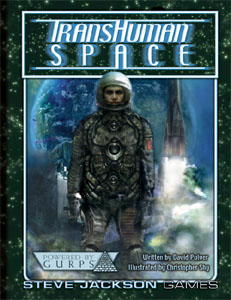This was originally posted as a response to a comment by Pasquale, but I thought it might interest a larger audience.
 Transhuman Space has earned a reputation as a rich and magnificent setting… which is also almost completely impenetrable to players and incredibly difficult for GMs to run. Pasquale asks whether or nor the Between the Stars campaign structure could be used to crack open Transhuman Space.
Transhuman Space has earned a reputation as a rich and magnificent setting… which is also almost completely impenetrable to players and incredibly difficult for GMs to run. Pasquale asks whether or nor the Between the Stars campaign structure could be used to crack open Transhuman Space.
The primary problem with Transhuman Space is that the complexity, depth, and density of the setting requires a heavy upfront investment from the players.
To give a basis of comparison:
My open table OD&D campaign relies almost entirely on common knowledge. If a player knows what an elf, dwarf, halfling, and wizard are, I can provide a functional basis for understanding the game world in about 60 seconds.
My dedicated 3.5 campaigns set in the Western Lands are a bit more involved: I have an 8 page handout (half of which consists of practical lists like “gods you can choose”, “languages you can choose”, etc.). It probably requires about 5-10 minutes from the players, with another 30 minutes or so dedicated to character creation.
Transhuman Space, on the other hand, doesn’t have a lingua franca of common genre tropes to fall back on. It is a very specific, very complex, and very deep setting. In order for most characters to function coherently in such a setting, the players need to have a specific, complex, and deep understanding of the setting.
Basically, a setting like that often requires that the players read most of the setting book for themselves. That requires hours of investment, and I’ve found that most players won’t commit it.
To make things worse, Transhuman Space was primarily designed to be an interesting setting for the sake of having an interesting setting, without any real consideration or focus given to the types of stories/games that can be told in that setting.
So, to answer Pasquale’s question at long last: Yes. I think you could use a structure similar to “Between the Stars” as a solution to both problems.
It’s been about 10 years since I read Transhuman Space, so take any specifics with a grain of salt, but the general approach I would take would look something like this:
(1) Set the PCs up as the crew of a tramp freighter. These vessels, due to their relative isolation and the difficulty of maintaining network connections and advanced tech on a mobile platform, end up being a lot more culturally conservative than the rest of the solar system. (In other words, their crews cleave a lot closer to early-21st century norms, so the players don’t have to “reach” as far to understand their characters.)
(2) The scenario structure needs to be tweaked somewhat to accommodate interplanetary travel instead of interstellar travel, but the basic principle of “key to the voyage” should still work.
(3) I would key each voyage to reveal some specific facet of the Transhuman Space setting. (Over time, therefore, the campaign would slowly introduce your players to its intricacies one chunk at a time.)
In terms of keying, this can actually be quite liberating. Flipping through the setting book randomly and just grabbing stuff off the page, for example, gives me:
A large group of executives from Nanodynamics is travelling to a base in the outer system to inspect the installation of zero-gee nanofabrication tools. But they’re being targeted by pro-union terrorists from the recently acquired Exogenesis Systems Technologies. (see page 95)
A poorly secured microbot swarm breaks loose in the ship’s cargo hold.
The crew is hired to make the long haul out to Miranda with 3HE mining supplies. There’s a spy onboard trying to figure out what China’s real intentions are for the Miranda colony. (see page 48)
A Felician combat bioroid sneaks onboard in an effort to escape her contract. A corporate hunting team, however, is trying to track her down. And since the Felician killed their captain, they may be more interested in vigilante justice than fulfilling their contract. (see page 116)
And so forth.
It might also be useful to check out “Getting the Players to Care“, which is primarily about how to parcel and structure exposition so that it’s not boring or overwhelming.











